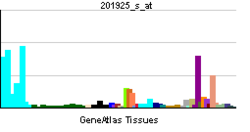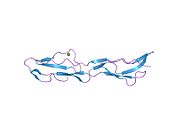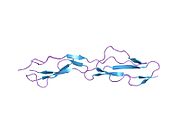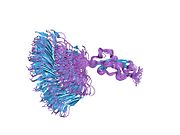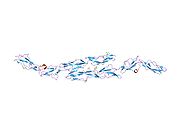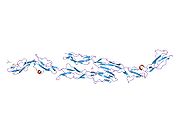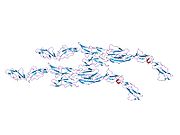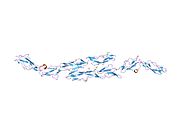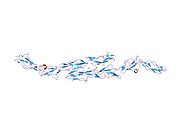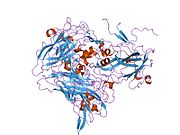- Decay-accelerating factor
-
Complement decay-accelerating factor also known as CD55 is a protein that, in humans, is encoded by the CD55 gene.[1]
Decay accelerating factor is a 70 kDa membrane protein that regulates the complement system on the cell surface. It prevents the assembly of the C3bBb complex (the C3-convertase of the alternative pathway) or accelerates the disassembly of preformed convertase, thus blocking the formation of the membrane attack complex.
This glycoprotein is broadly distributed among hematopoietic and non-hematopoietic cells. It is a determinant for the Cromer blood group system.
Contents
Pathology
DAF is not expressed on paroxysmal nocturnal hemoglobinuria III (markedly abnormal) RBCs; this, coupled with CD59 absence leads to PNH.
Infectious diseases
DAF is used as a receptor by some coxsackieviruses and other enteroviruses.[2] Recombinant soluble DAF-Fc has been tested in mice as an anti-enterovirus therapy for heart damage;[3] however, the human enterovirus that was tested binds much more strongly to human DAF than to mouse or rat DAF. Echoviruses and coxsackie B viruses that use human decay-accelerating factor (DAF) as a receptor do not bind the rodent analogues of DAF.[4] and DAF-Fc has yet to be tested in humans.
See also
References
- ^ Medof ME, Lublin DM, Holers VM, Ayers DJ, Getty RR, Leykam JF, Atkinson JP, Tykocinski ML (April 1987). "Cloning and characterization of cDNAs encoding the complete sequence of decay-accelerating factor of human complement". Proc. Natl. Acad. Sci. U.S.A. 84 (7): 2007–11. doi:10.1073/pnas.84.7.2007. PMC 304572. PMID 2436222. http://www.pubmedcentral.nih.gov/articlerender.fcgi?tool=pmcentrez&artid=304572.
- ^ Karnauchow TM, Tolson DL, Harrison BA, Altman E, Lublin DM, Dimock K (August 1996). "The HeLa cell receptor for enterovirus 70 is decay-accelerating factor (CD55)". J. Virol. 70 (8): 5143–52. PMC 190469. PMID 8764022. http://www.pubmedcentral.nih.gov/articlerender.fcgi?tool=pmcentrez&artid=190469.
- ^ Yanagawa B, Spiller OB, Choy J, Luo H, Cheung P, Zhang HM, Goodfellow IG, Evans DJ, Suarez A, Yang D, McManus BM (January 2003). "Coxsackievirus B3-associated myocardial pathology and viral load reduced by recombinant soluble human decay-accelerating factor in mice". Lab. Invest. 83 (1): 75–85. PMID 12533688.
- ^ Spiller OB, Goodfellow IG, Evans DJ, Almond JW, Morgan BP (January 2000). "Echoviruses and coxsackie B viruses that use human decay-accelerating factor (DAF) as a receptor do not bind the rodent analogues of DAF". J. Infect. Dis. 181 (1): 340–3. doi:10.1086/315210. PMID 10608785.
Further reading
- Selinka HC, Wolde A, Sauter M, et al. (2004). "Virus-receptor interactions of coxsackie B viruses and their putative influence on cardiotropism.". Med. Microbiol. Immunol. 193 (2-3): 127–31. doi:10.1007/s00430-003-0193-y. PMID 12920584.
- Mikesch JH, Schier K, Roetger A, et al. (2007). "The expression and action of decay-accelerating factor (CD55) in human malignancies and cancer therapy.". Cell. Oncol. 28 (5-6): 223–32. PMID 17167176.
External links
- MeSH Decay-Accelerating+Factor
- Cromer blood group system at BGMUT Blood Group Antigen Gene Mutation Database at NCBI, NIH
PDB gallery 1h03: HUMAN CD55 DOMAINS 3 & 41h04: HUMAN CD55 DOMAINS 3 & 41h2p: HUMAN CD55 DOMAINS 3 & 41h2q: HUMAN CD55 DOMAINS 3 & 41nwv: SOLUTION STRUCTURE OF A FUNCTIONALLY ACTIVE COMPONENT OF DECAY ACCELERATING FACTOR1ojv: DECAY ACCELERATING FACTOR (CD55): THE STRUCTURE OF AN INTACT HUMAN COMPLEMENT REGULATOR.1ojw: DECAY ACCELERATING FACTOR (CD55): THE STRUCTURE OF AN INTACT HUMAN COMPLEMENT REGULATOR.1ojy: DECAY ACCELERATING FACTOR (CD55): THE STRUCTURE OF AN INTACT HUMAN COMPLEMENT REGULATOR.1ok1: DECAY ACCELERATING FACTOR (CD55): THE STRUCTURE OF AN INTACT HUMAN COMPLEMENT REGULATOR.1ok2: DECAY ACCELERATING FACTOR (CD55): THE STRUCTURE OF AN INTACT HUMAN COMPLEMENT REGULATOR.1ok3: DECAY ACCELERATING FACTOR (CD55): THE STRUCTURE OF AN INTACT HUMAN COMPLEMENT REGULATOR.1ok9: DECAY ACCELERATING FACTOR (CD55): THE STRUCTURE OF AN INTACT HUMAN COMPLEMENT REGULATOR.1uot: HUMAN CD55 DOMAINS 3 & 41upn: COMPLEX OF ECHOVIRUS TYPE 12 WITH DOMAINS 3 AND 4 OF ITS RECEPTOR DECAY ACCELERATING FACTOR (CD55) BY CRYO ELECTRON MICROSCOPY AT 16 AProteins: complement system (C, L, A) Activators/enzymes EarlyMiddleLateInhibitors Complement receptors 1-50 CD1 (a-c, 1A, 1D, 1E) · CD2 · CD3 (γ, δ, ε) · CD4 · CD5 · CD6 · CD7 · CD8 (a) · CD9 · CD10 · CD11 (a, b, c) · CD13 · CD14 · CD15 · CD16 (A, B) · CD18 · CD19 · CD20 · CD21 · CD22 · CD23 · CD24 · CD25 · CD26 · CD27 · CD28 · CD29 · CD30 · CD31 · CD32 (A, B) · CD33 · CD34 · CD35 · CD36 · CD37 · CD38 · CD39 · CD40 · CD41 · CD42 (a, b, c, d) · CD43 · CD44 · CD45 · CD46 · CD47 · CD48 · CD49 (a, b, c, d, e, f) · CD5051-100 CD51 · CD52 · CD53 · CD54 · CD55 · CD56 · CD57 · CD58 · CD59 · CD61 · CD62 (E, L, P) · CD63 · CD64 (A, B, C) · CD66 (a, b, c, d, e, f) · CD68 · CD69 · CD70 · CD71 · CD72 · CD73 · CD74 · CD78 · CD79 (a, b) · CD80 · CD81 · CD82 · CD83 · CD84 · CD85 (a, d, e, h, j, k) · CD86 · CD87 · CD88 · CD89 · CD90 · CD91- CD92 · CD93 · CD94 · CD95 · CD96 · CD97 · CD98 · CD99 · CD100101-150 CD101 · CD102 · CD103 · CD104 · CD105 · CD106 · CD107 (a, b) · CD108 · CD109 · CD110 · CD111 · CD112 · CD113 · CD114 · CD115 · CD116 · CD117 · CD118 · CD119 · CD120 (a, b) · CD121 (a, b) · CD122 · CD123 · CD124 · CD125 · CD126 · CD127 · CD129 · CD130 · CD131 · CD132 · CD133 · CD134 · CD135 · CD136 · CD137 · CD138 · CD140b · CD141 · CD142 · CD143 · CD144 · CD146 · CD147 · CD148 · CD150151-200 CD151 · CD152 · CD153 · CD154 · CD155 · CD156 (a, b, c) · CD157 · CD158 (a, d, e, i, k) · CD159 (a, c) · CD160 · CD161 · CD162 · CD163 · CD164 · CD166 · CD167 (a, b) · CD168 · CD169 · CD170 · CD171 · CD172 (a, b, g) · CD174 · CD177 · CD178 · CD179 (a, b) · CD181 · CD182 · CD183 · CD184 · CD185 · CD186 · CD191 · CD192 · CD193 · CD194 · CD195 · CD196 · CD197 · CDw198 · CDw199 · CD200201-250 CD201 · CD202b · CD204 · CD205 · CD206 · CD207 · CD208 · CD209 · CDw210 (a, b) · CD212 · CD213a (1, 2) · CD217 · CD218 (a, b) · CD220 · CD221 · CD222 · CD223 · CD224 · CD225 · CD226 · CD227 · CD228 · CD229 · CD230 · CD233 · CD234 · CD235 (a, b) · CD236 · CD238 · CD239 · CD240CE · CD240D · CD241 · CD243 · CD244 · CD246 · CD247- CD248 · CD249251-300 CD252 · CD253 · CD254 · CD256 · CD257 · CD258 · CD261 · CD262 · CD264 · CD265 · CD266 · CD267 · CD268 · CD269 · CD271 · CD272 · CD273 · CD274 · CD275 · CD276 · CD278 · CD279 · CD280 · CD281 · CD282 · CD283 · CD284 · CD286 · CD288 · CD289 · CD290 · CD292 · CDw293 · CD294 · CD295 · CD297 · CD298 · CD299301-350 Categories:- Human proteins
- Blood
- Transfusion medicine
- Hematology
- Blood antigen systems
- Biochemistry stubs
- Immunology stubs
Wikimedia Foundation. 2010.


